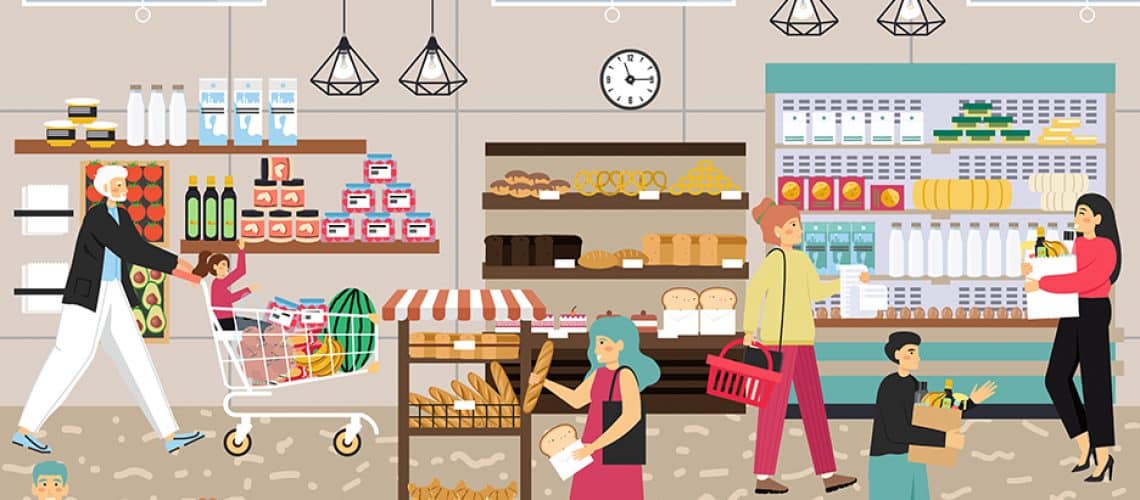Smaller Can Be Better—Small-format Stores Are Increasing in Numbers

Most people have heard the phrase, “Good things come in small packages.” This phrase does not just direct its meaning towards products, it also applies to the food retail industry as small-format retail stores are rapidly growing.
Small-format stores, such as Lidl and Trader Joe’s, are some of the leading neighborhood stores in the country and have been quite successful in that niche. Other food retail businesses are following suit, hoping to maximize sales and target customers in their locality. But what makes these small-format retail stores so successful, even to the point of outperforming some much larger traditional grocery stores?
Meeting Customers Where They Are
Perhaps one of the key factors that make small-format stores tick is the promise of convenience to customers. At a time when people are prioritizing convenience and wanting to get their groceries wherever and whenever small-format stores check all the right boxes. Neighborhood stores meet customers where they are, allowing them to shop closer to home—whether in rural areas or metropolitan centers like New York where Target opened its 30,000 square foot store in Times Square.
More than just the smaller footprint, small-format stores also enable retailers to localize and personalize their products and services to cater to the needs of their immediate community. Through these targeted products and services and well-curated store space, neighborhood stores have a great advantage in drawing in new customers and keeping existing ones.
The Opportunity to Minimize Costs
Knowing that the capital needed to develop food retail space can get very costly, the shift towards reducing store footprint to manage cost is not just logical, but a smart move. Moreover, due to the recent crises that have affected the food retail industry in more ways than one, downsizing retail space drives the opportunity to minimize costs and recoup past operational losses.
The footprint of a small-format store generally ranges from 12,000 square feet to 25,000 square feet. “Going small” is an effective way to cut costs on infrastructure and fixtures without sacrificing operational performance. With reduced floor space, retailers can invest in equipment, such as refrigeration solutions and display cases that are suitable and designed for small-format applications rather than full-size stores. With the intimate and smaller nature of neighborhood markets, retailers have the upper hand in being flexible with their strategies without going overboard with their budgets or sacrificing product offerings.
Although smaller in square footage than the full-size stores, the neighborhood stores category is projected to grow big in the coming years. The strategic adoption of small-format stores is an ode to our commitment to continuously strive to innovate in the food retail landscape. After all, as food retailers, our impact on the communities we serve is not dependent on the size of our stores, but on the value, we offer our customers.
Fresh Thinking...
Categories
- AIM Act
- AMS Group
- Clarity
- Close The Case
- Convenience Store
- Coolgenix
- Deli
- Design Center
- Display Case
- Food Retail
- Food Safety
- Foodservice
- Fresh Prepared
- Grocerant
- Industrial
- Learning Center
- Lighting
- Meal Kits
- Meat
- Merchandising
- Merchandising Matters
- Power Systems
- Refrigeration Regulations
- Refrigeration Systems
- Seafood
- Second Nature & CO2
- Supermarket
- Trends
- Uncategorized
Archives
- June 2025
- May 2025
- April 2025
- March 2025
- February 2025
- January 2025
- October 2024
- July 2024
- June 2024
- March 2024
- January 2024
- October 2023
- May 2023
- April 2023
- February 2023
- January 2023
- December 2022
- November 2022
- October 2022
- September 2022
- August 2022
- July 2022
- June 2022
- May 2022
- April 2022
- March 2022
- February 2022
- January 2022
- December 2021
- November 2021
- October 2021
- September 2021
- August 2021
- July 2021
- June 2021
- May 2021
- April 2021
- March 2021
- February 2021
- January 2021
- December 2020
- November 2020
- October 2020
- September 2020
- August 2020
- July 2020
- April 2020
- February 2020
- December 2019
- October 2019
- July 2019
- June 2019
- April 2019
- March 2019
- January 2019
- December 2018
- October 2018
- September 2018
- August 2018
- July 2018
- June 2018
- November 2017
- August 2017
- July 2017
- October 2016
- September 2016
- August 2016
- July 2016
- June 2016
- May 2016
- April 2016
- March 2016
- February 2016
- January 2016
- November 2015
- October 2015
- September 2015
- August 2015
- July 2015
- June 2015
- May 2015
- April 2015